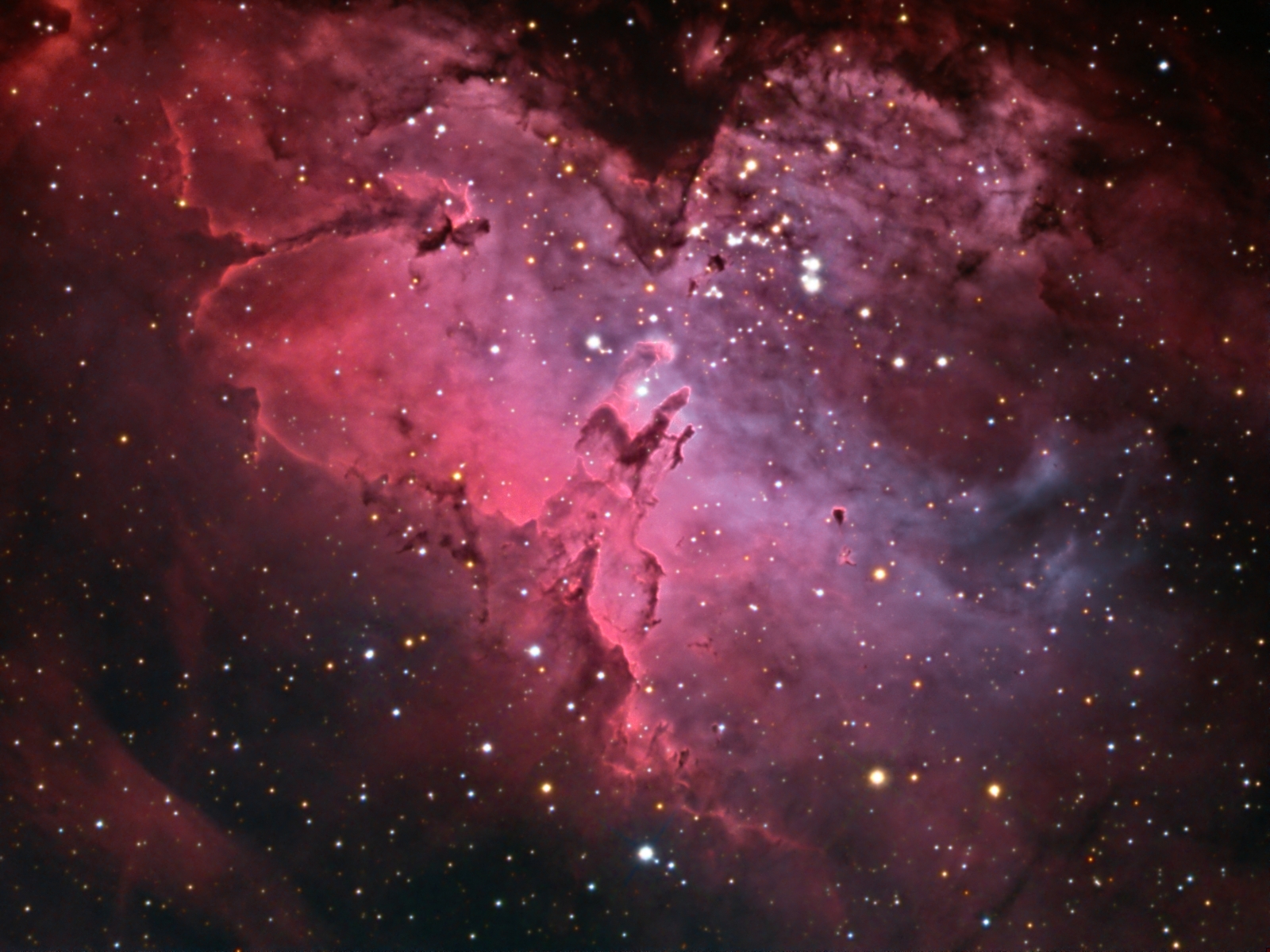M16, Pillars of Creation
 Click image for full size version
Click image for full size version
August 15, 2016. Collaboration with Peter Proulx.
The Pillars of Creation lie within the Eagle Nebula (M16) in Serpens. They are about 9.5 light years tall (90 trillion km). I have previously posted a wider field image of the Eagle Nebula, and more information about it is posted there.
For this image, I combined my broadband colour data with high-resolution narrow band data collected through H-alpha, Oxygen-3 and Sulfur-2 filters. The narrowband data was collected and pre-processed by Peter Proulx, in Sanborn, New York.
Tekkies:
Ron’s RGB Data:
SBIG STL-11000M camera, Baader RGB filters, 10″ f/6.8 ASA astrograph, MI-250 mount. Guided with STL-11000’s external guider and a 500mm f.l. Lumicon guide scope. Acquistion, guiding, calibration, registration and integration all done using Maxim-DL. Focusing with FocusMax. All processing in PixInsight. Shot from my SkyShed in Guelph, Ontario. Waxing gibbous moon and good transparency. Seeing was average on all nights.
9x5m of R and B, 8x5m G (total 1hr55m).
Pete’s Narrowband Data:
QSI683 camera, Astrodon Ha,O2,S3 (5nm) filters, 10″ f/8 Meade RCX400, Meade Fork Mount. Guided with Starlight Lodestar SX-LFAO. Acquisition, guiding and Focusing using Maxim-DL. Shot from my roll off roof observatory in Sanborn, New York. Seeing was average on all nights.
Initial Steps:
Pete and I each pre-processed our own data. All of the masters (R, G, B, Ha, O3, S2) were aligned with ImageRegistration and the edges cropped.
Synthetic Luminance:
Creation and cleanup: The Ha, O3 and S2 masters were combined using the ImageIntegration tool (average, additive with scaling, noise evaluation, iterative K-sigma / biweight midvariance, no pixel rejection). DBE was applied to neutralize the background.
Deconvolution: A star mask was made to use as a local deringing support. A copy of the image was stretched to use as a range mask. Regularized Richardson-Lucy Deconvolution was applied (30 iterations, global dark deringing = 0.05; local deringing 0.9, external PSF made using DynamicPSF tool with about 30 stars).
Linear Noise Reduction: MultiscaleLinearTransform was used to reduce noise in the background areas. Layer settings for threshold and strength: Layer 1: 3.0, 0.5 Layer 2: 2.0, 0.35 Layer 3: 1.0, 0.2 Layer 4: 0.5, 0.1
Stretching: HistogramTransformation was applied to make a pleasing yet bright image.
The R, G and B channels were combined to make an RGB image. ColourCalibration was applied, and the Ha, O3 and RGB were combined with the NB-RGB script, assigning O3 to both green and blue channels, and the sum of Ha and S2 to the red channel.
Linear Noise Reduction: MultiscaleLinearTransform was used to reduce noise in the background areas. Layer settings for threshold and strength: Layer 1: 3.0, 0.5 Layer 2: 2.0, 0.35 Layer 3: 1.0, 0.2 Layer 4: 0.5, 0.1
Stretching: HistogramTransformation was applied to make a pleasing yet bright image.
SynthL stars were increased in size using a mask and pixel math to replace the stars with those from the luminance channel of the HaO3RGB image.
The luminance was extracted from the HaO3RGB image, processed and then added back into the HaO3RGB image as follows:
1. Extract luminance from the HaO3RGB image.
2. Apply LinearFit using the SynthL channel as a reference.
3. Use ChannelCombination in the Lab mode to replace the luminance of the HaO3RGB with the fitted luminance from step 2.
4. Use LRGBCombine to apply SynthL to the HaO3RGB image.
Additional Processing
Noise Reduction and Re-Stretch: TGVDenoise was applied in Lab mode with 300 iterations with a range mask used to protect nebula and stars. This was followed by a HistogramTransformation to raise the black point (but with no clipping).
LHE: LocalHistogramEqualization was applied to bright areas to increase contrast.
Sharpening: MLT and UnsharpMask were used to sharpen the bright areas of the nebula
Star Reduction and Colour Adjustment: Morphological transformation (3×3, 4 iterations, strength 0.15) was applied using a star mask to protect background and nebula. The same mask was used with ColourSaturation to boost star colours.
Dark Structures: DarkStructureEnhance script was applied with a strength of 0.25.
Final Steps: Background, stars and nebula brightness, contrast and saturation were adjusted in several iterations using Curves with masks as required.
Image scale is about 0.56 arcsec per pixel based on Pete’s camera / telescope combination.






Leave A Comment